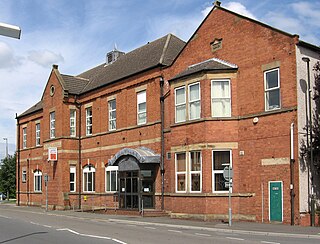
Staveley is a town and civil parish in the Borough of Chesterfield, Derbyshire, England. Located along the banks of the River Rother. It is northeast of Chesterfield, west of Clowne, northwest of Bolsover, southwest of Worksop and southeast of Sheffield.

Chesterfield is a market town and unparished area in the Borough of Chesterfield, Derbyshire, England, 24 miles (39 km) north of Derby and 11 miles (18 km) south of Sheffield at the confluence of the River Rother and River Hipper. In 2011 the built-up-area subdivision had a population of 88,483, making it the second-largest settlement in Derbyshire, after Derby. The wider borough had a population of 103,801 in 2011. In 2011, the town had a population of 76,753. It has been traced to a transitory Roman fort of the 1st century CE. The name of the later Anglo-Saxon village comes from the Old English ceaster and feld (pasture). It has a sizeable street market three days a week. The town sits on an old coalfield, but little visual evidence of mining remains. The main landmark is the crooked spire of the Church of St Mary and All Saints.

The Chesterfield Canal is a narrow canal in the East Midlands of England and it is known locally as 'Cuckoo Dyke'. It was one of the last of the canals designed by James Brindley, who died while it was being constructed. It was opened in 1777 and ran for 46 miles (74 km) from the River Trent at West Stockwith, Nottinghamshire to Chesterfield, Derbyshire, passing through the Norwood Tunnel at Kiveton Park, at the time one of the longest tunnels on the British canal system. The canal was built to export coal, limestone, and lead from Derbyshire, iron from Chesterfield, and corn, deals, timber, groceries and general merchandise into Derbyshire. The stone for the Palace of Westminster was quarried in North Anston, Rotherham, and transported via the canal.

The River Rother, a waterway in the northern midlands of England, gives its name to the town of Rotherham and to the Rother Valley parliamentary constituency. It rises near Clay Cross in Derbyshire and flows in a generally northwards direction through the centre of Chesterfield, where it feeds the Chesterfield Canal, and on through the Rother Valley Country Park and several districts of Sheffield before joining the River Don at Rotherham in Yorkshire. Historically, it powered mills, mainly corn or flour mills, but most had ceased to operate by the early 20th century, and few of the mill buildings survive.

Killamarsh is a town and civil parish in North East Derbyshire, England, bordering Sheffield and South Yorkshire to the north-west. Killamarsh is surrounded by, in a clockwise direction from the north, Rother Valley Country Park, the village of Wales, South Yorkshire, Kiveton, Woodall, Harthill, Barlborough, Spinkhill, Renishaw, Eckington, and the Sheffield suburbs of Oxclose, Halfway and Holbrook.
Chesterfield Borough Council elections are held every four years. Chesterfield Borough Council is the local authority for the non-metropolitan district of Chesterfield in Derbyshire, England. Since the last boundary changes in 2003, 48 councillors have been elected from 20 wards.
Milton is a residential area of the English city of Portsmouth, Hampshire, England, on the south eastern side of Portsea Island. Milton is bordered on the eastern coast of Portsea Island by Langstone Harbour, with Eastney to the south-east, Southsea to the south-west, Baffins to the north and Fratton to the north-west.

Brimington is a large village and civil parish in the Borough of Chesterfield in Derbyshire, England. The population of the parish taken at the 2011 census was 8,788. The town of Staveley is to the east, and Hollingwood is nearby. The parish includes Brimington Common along the Calow Road, and New Brimington, a late 19th-century extension towards the Staveley Iron Works.

The Adelphi Canal was a small privately owned canal in Duckmanton, near Chesterfield, England, built in 1799. It was used to transport pig iron from an ironworks to a wharf by a road. It is not connected to any waterway. The iron was forwarded by road to the Chesterfield Canal.

Staveley Central was a railway station serving the town of Staveley, Derbyshire, England.

Tapton is a suburb of Chesterfield, in the county of Derbyshire, England. It is located along the Brimington Road B6543, between Chesterfield town centre, and Brimington. It became a suburb of Chesterfield in the 1920s. The buildings along Brimington road, which runs through the centre of Tapton, are testament to this fact. Consisting of semi-detached houses in a style typical of the 20s and 30s.

Barrow Hill railway station is a former railway station in the village of Barrow Hill in northern Derbyshire, England.
Springwell Community College is a coeducational secondary school located in Staveley, Derbyshire, England.

The Chesterfield Canal Trust Limited is a waterway society and charitable company which campaigns for and undertakes various activities related to the Chesterfield Canal, which runs from Chesterfield in Derbyshire, England to the River Trent at West Stockwith.
The Doe Lea branch is a mothballed railway line in Derbyshire, England. It connected the Derbyshire towns of Chesterfield, Staveley and Bolsover to the Nottinghamshire town of Mansfield. It also had a branch line to Creswell via the Derbyshire town of Clowne.
Staveley is a civil parish in the Borough of Chesterfield in Derbyshire, England. The parish contains 26 listed buildings that are recorded in the National Heritage List for England. Of these, two are listed at Grade II*, the middle of the three grades, and the others are at Grade II, the lowest grade. The parish contains the town of Staveley, the village of Barrow Hill, and the surrounding area. Most of the listed buildings are houses and associated structures, farmhouses and farm buildings. The other listed buildings include churches and a cross in a churchyard, schools, a railway engine shed and a war memorial.












